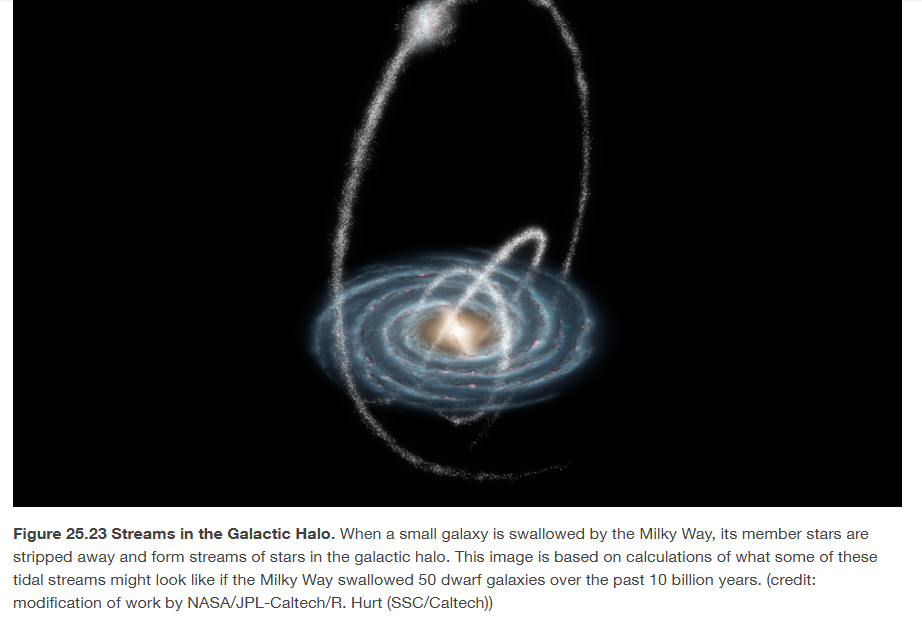chapter 25.1 architecture of galaxy & 25.2 spiral structure & the mass of Galaxy & the centre of the Galaxy & stellar populations in Galaxy & 25.6 formation of Galaxy
1/16
There's no tags or description
Looks like no tags are added yet.
Name | Mastery | Learn | Test | Matching | Spaced |
|---|
No study sessions yet.
17 Terms
features of Galaxy
brightest part of Galaxy: consists of a thin, circular, rotating disk of stars distributed across a region about 100,000 light-years in diameter and about 2000 light years thick
youngest stars and the dust and gas from which stars form, are found within 100 light years of the plane of the Galaxy
mass of the interstellar matter is about 15% of the mass of the stars in this disk
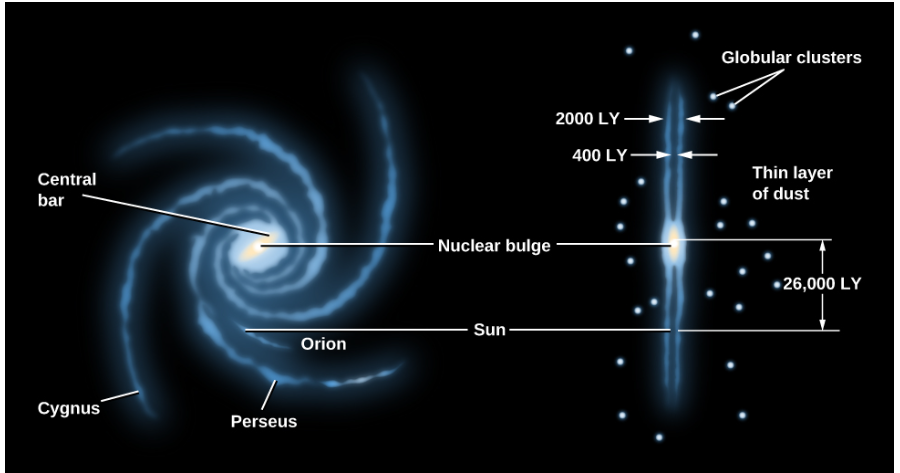
stars, gas and dust are not spread evenly throughout the disk but are concentrated into a central bar and a series of spiral arms
central bar composed of mostly old yellow-red stars
two main spiral arms appear to connect with the ends of the bar (blue light because they contain young, hot stars)
the Sun is located about halfway between the center of the Galaxy and the edge of the disk, and only about 70 light years above its central plane

thin disk of young stellar matter
think disk of young stars, gas and dust is embedded in a thicker but more diffuse disk of older stars
thicker disk extends about 1000 light years above and 1000 below the midplane of the thin disk, and contains only about 5% as much mass as the thin disk
stars thin out with distance from the galactic plane
central bulge/nuclear bulge
close to the galactic center (within about 10,000 light-years), the stars no longer confined to the disk, but form a central bulge
bulge often obscured by dust, therefore hard to observe and determine its shape
shaped like a peanut
halo
the thin and thick disks and the nuclear bulge of our Galaxy are embedded in a spherical halo of very old, faint stars that extends to a distance of at least 150,000 light years from the galactic centre
most of the globular clusters are also found in this halo
dark matter
the invisible mass of the Milky Way that extends beyond the boundary of luminous stars to a distance of at least 200,000 light years from the centre of the Galaxy
emits no light, and cannot be seen with any telescope
composition is unkown
can only be detected because of its gravitational effects on the motions of luminous matter that we can see
we know that this dark matter halo exists because of its effects on the orbits of distant star clusters and other dwarf galaxies that are associated with the Galaxy
characteristics of the Milky Way
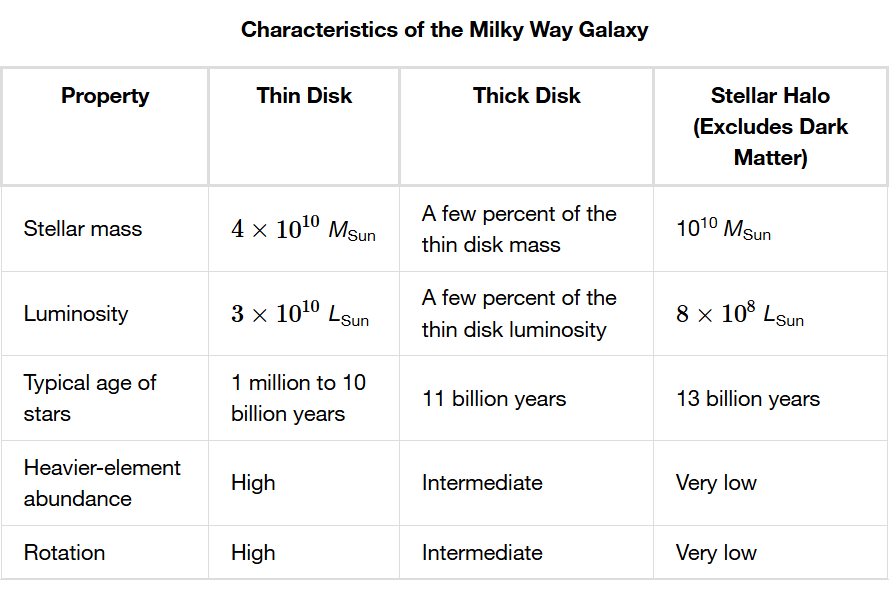

arms of the Milky Way
radio observations of the disk’s gaseous component indicate that the Galaxy has 2 major spiral arms that energy from the bar and several fainter arms and shorter spurs
Sun is near the inner edge of a short arm/spur called the Orion-Cygnus Arm (10,000ly long)
formation of spiral structure
the way objects turn around the center of the Galaxy follows Kepler’s third law
objects farther from the center take longer to complete an orbit around the Galaxy
differential rotation explains why so much of the material in the disk of the Milky Way is concentrated in elongated features that resemble spiral arms
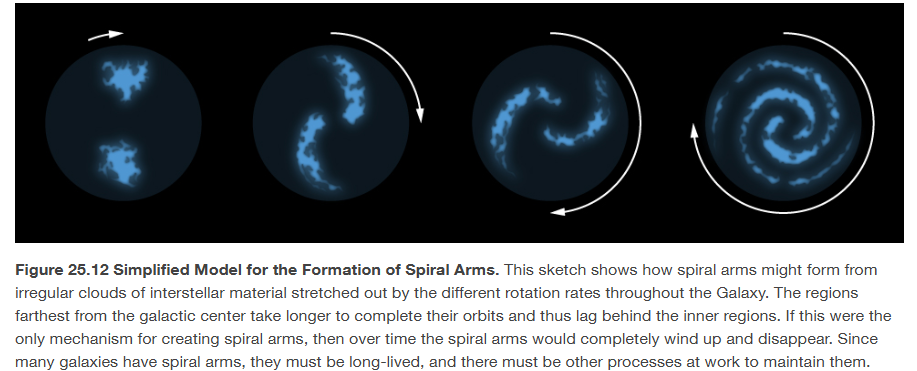
differential galactic rotation
objects further from the Galaxy center take longer to complete an orbit around the Galaxy than do those closer to the center
stars in larger orbits in the galaxy trail behind those in smaller ones
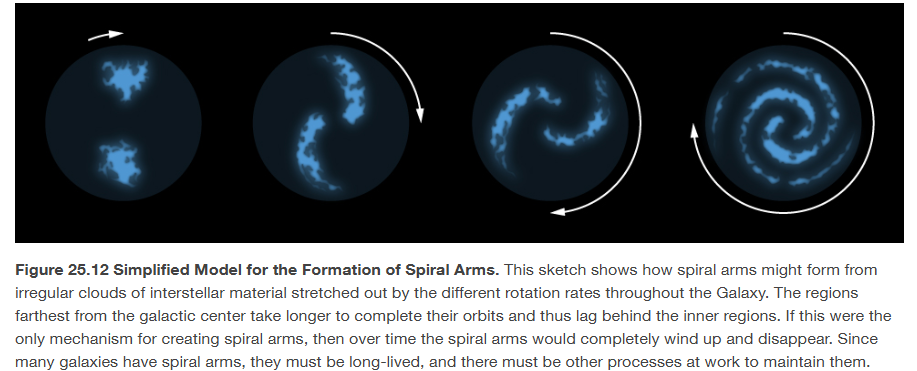
Sun’s orbit around the centre of the Galaxy
orbits the center of the Milky Way
Sun’s orbit is nearly circular and lies in the Galaxy’s disk
speed of the Sun in orbit is about 200lm/s, which means it takes us approx. 225 million years to go once around the center of the Galaxy (galactic year)
total mass of Galaxy
at least 2 × 10^12 Msun
make up of dark matter
only possibility that works is it is composed of exotic subatomic particles that have not been detected on Earth
centre of the Galaxy
the very centre contains a black hole with the mass equivalent to 4.6 million Suns
all this mass fits within a sphere that has less than the diameter of Mercury’s orbit
called a supermassive black hole
indicates that the mass they contain is far greater than that of the typical black hole created by the death of a single star
can grow by swallowing clouds of gas and nearby stars, and merging with other black holes
at the current rate, we observe clouds of gas and dust falling into the galactic center at the rate of about 1 Msun per thousand years
currently no star formation at the galactic centre, but there is lots of dust and molecular gas that is revolving around the black hole, along with some ionised gas streamers that are heated by the hot stars
Sagittarius A* lies at the centre
population I
bright blue stars that are found in the spiral arms of galaxies
only found in the disk and follow nearly circular orbits around the galactic centre
e.g. bright supergiant stars, main-sequence stars of highs luminosity (O,B), members of young open star clusters
interstellar matter and molecular clouds are found in the same places as population I stars
wide range of ages
heavy elements account for 1-4% of the total stellar mass
population II
all stars in the halo and globular clusters of a galaxy
shows no correlation with the location of the spiral arms
found throughout the galaxy
some are in disk, many follow eccentric elliptical orbits that carry them high above the galactic disk into the halo
e.g. stars surrounded by planetary nebulae and RR Lyrae variable stars, stars in globular clusters
consists of stars that formed very early in the history of the Galaxy, typical ages are 11-13 billion years
less than 1/100th the concentration of heavy elements found in the Sun and sometimes lower
these stars were formed when the abundance of heavy elements was low
protogalactic cloud
gave birth to our Galaxy
assumed to be roughly spherical
formation of Galaxy: cloud collapsed and formed a thin rotating disk
gravitational forces caused the gas in the thin disk to fragment into clouds or clumps with masses like those of star clusters
these individual clouds then fragmented further to form stars
since the oldest stars in the disk are nearly as old as the youngest stars in the halo, the collapse must have been rapid, requiring no more than a few hundred million years
tidal stream
occurs when smaller galaxies pass close to the Milky Way, with the gravity of our Galaxy tugging on harder on the near side than the far side of the other galaxy
the net effect is that the stars that originally belonged to the small galaxy are spread out into a long stream that orbits through the halo of the Milky Way
can maintain its identity for billions of years
